V-STAR: A Cloud-Based Tool for Satellite Detection and Mapping of Volcanic Thermal Anomalies
Abstract
1. Introduction
2. Materials
2.1. Volcano Selection
- Etna, an active basaltic stratovolcano on the eastern coast of Sicily (Italy), is characterized by frequent effusive eruptions, persistent Strombolian activity, and periodic paroxysmal events. The latter is marked by high ash plumes and lava outflows from the summit craters [39].
- Stromboli, the northeasternmost island of the Aeolian Archipelago, exhibits persistent low-intensity explosive activity. This ordinary Strombolian activity is occasionally interrupted by lava overflows, major explosions, or paroxysmal events [40].
- Klyuchevskoy is an active basaltic–andesitic stratovolcano in Kamchatka. Recent eruptions have involved the effusion of voluminous lava flows and moderate to strong explosive activity [41].
- Shiveluch, also located in Kamchatka, is a highly active andesitic stratovolcano that has produced explosive eruptions, lava dome extrusions, and large-scale structural collapses throughout the Holocene [42].
- Popocatépetl, a large andesitic stratovolcano in central Mexico, is currently characterized by vulcanian explosions, gas-rich ash emissions, and episodic dome growth and destruction cycles [45].
- Fuego, in Guatemala, is a persistently active stratovolcano with continuous low-intensity Strombolian eruptions, lava effusions, ash-rich explosions, and occasional high-energy paroxysmal events [46].
- Pacaya, also in Guatemala, is an active basaltic volcano exhibiting Strombolian activity, intermittent Plinian eruptions, lava flows, and dome growth [47].
- Santiaguito is a dacitic lava dome complex in Guatemala that has shown continuous lava extrusion, frequent ash and gas explosions, partial dome collapses, and short-runout pyroclastic flows [48].
- Telica, in western Nicaragua, is a basaltic–andesitic volcano located within the Maribios Range. Its activity includes low-energy phreatic explosions every 2–3 years and more violent episodes on a decadal scale [49].
- Kīlauea, a basaltic shield volcano in Hawaii, alternates between phases dominated by effusive fissure eruptions and periods of explosive summit activity, typical of Hawaiian-style volcanism [50].
- Erta Ale, in Ethiopia’s Afar Rift, is renowned for its long-lived lava lake and continuous effusive activity. The volcano is situated in a tectonically active region dominated by magma-assisted rifting [51].
2.2. Satellite Data
3. Methods
3.1. The Algorithm: Random-Forest-Based Two-Step Classification Model
- Accuracy
- Precision (also known as the positive predictive value (PPV))
- Recall (also known as the true positive rate (TPR))
3.2. The Platform: Google Earth Engine (GEE)
3.3. Exploring the Interface: Features and Tools
- NHI(SWIR–SWIR) = (B12 − B11)/(B12 + B11), where B11 and B12 are both shortwave infrared (SWIR) bands.
- NHI(NIR–SWIR) = (B11 − B8A)/(B11 + B8A), where B8A is the near-infrared (NIR) band and B11 is an SWIR band.
4. Results
4.1. Identification of Unrest/Quiescence Periods of Active Volcanoes
4.2. Lava Flow Monitoring and Mapping
4.3. Localization of Active Vents and Thermal Anomaly Assessment
5. Discussion
6. Conclusions
Author Contributions
Funding
Data Availability Statement
Acknowledgments
Conflicts of Interest
References
- Bevilacqua, A.; Pitman, E.B.; Patra, A.; Neri, A.; Bursik, M.; Voight, B. Probabilistic enhancement of the Failure Forecast Method using a stochastic differential equation and application to volcanic eruption forecasts. Front. Earth Sci. 2019, 7, 135. [Google Scholar] [CrossRef]
- Harris, A. Thermal Remote Sensing of Active Volcanoes: A User’s Manual; Cambridge University Press: Cambridge, UK, 2013. [Google Scholar]
- Ganci, G.; Cappello, A.; Bilotta, G.; Del Negro, C. How the variety of satellite remote sensing data over volcanoes can assist hazard monitoring efforts: The 2011 eruption of Nabro volcano. Remote Sens. Environ. 2020, 236, 111426. [Google Scholar] [CrossRef]
- HOTSAT: A Multiplatform System for the Thermal Monitoring of Volcanic Activity Using Satellite Data; Geological Society: London, UK, 2016. [CrossRef]
- Abrams, M.; Abbott, E.; Kahle, A. Combined use of visible, reflected infrared, and thermal infrared images for mapping Hawaiian lava flows. J. Geophys. Res. Solid Earth 1991, 96, 475–484. [Google Scholar] [CrossRef]
- Corradino, C.; Ganci, G.; Bilotta, G.; Cappello, A.; Del Negro, C.; Fortuna, L. Smart Decision Support Systems for Volcanic Applications. Energies 2019, 12, 1216. [Google Scholar] [CrossRef]
- Patrick, M.R.; Kauahikaua, J.; Orr, T.; Davies, A.; Ramsey, M. Operational Thermal Remote Sensing and Lava Flow Monitoring at the Hawaiian Volcano Observatory; Geological Society: London, UK, 2016; Volume 426, pp. 489–503. [Google Scholar] [CrossRef]
- Cariello, S.; Corradino, C.; Del Negro, C. How artificial intelligence can enhance monitoring of volcanoes from space. Il Nuovo Cimento 2024, 100, 47. [Google Scholar]
- Pergola, N.; D’Angelo, G.; Lisi, M.; Marchese, F.; Mazzeo, G.; Tramutoli, V. Time Domain Analysis of Robust Satellite Techniques (RST) for Near Real-Time Monitoring of Active Volcanoes and Thermal Precursor Identification. Phys. Chem. Earth 2009, 34, 380–385. [Google Scholar] [CrossRef]
- Spinetti, C.; Mazzarini, F.; Casacchia, R.; Colini, L.; Neri, M.; Behncke, B.; Salvatori, R.; Buongiorno, M.F.; Pareschi, M.T. Spectral properties of volcanic materials from hyperspectral field and satellite data compared with LiDAR data at Mt. Etna. Int. J. Appl. Earth Obs. Geoinf. 2009, 11, 142–155. [Google Scholar] [CrossRef]
- Ganci, G.; Vicari, A.; Cappello, A.; Del Negro, C. An Emergent Strategy for Volcano Hazard Assessment: From Thermal Satellite Monitoring to Lava Flow Modeling—ScienceDirect. Remote Sens. Environ. 2012, 119, 197–207. [Google Scholar] [CrossRef]
- Calvari, S.; Di Traglia, F.; Ganci, G.; Giudicepietro, F.; Macedonio, G.; Cappello, A.; Nolesini, T.; Pecora, E.; Bilotta, G.; Centorrino, V.; et al. Overflows and pyroclastic density currents in March-April 2020 at Stromboli volcano detected by remote sensing and seismic monitoring data. Remote Sens. 2020, 12, 3010. [Google Scholar] [CrossRef]
- Torrisi, F.; Corradino, C.; Cariello, S.; Del Negro, C. Enhancing detection of volcanic ash clouds from space with convolutional neural networks. J. Volcanol. Geotherm. Res. 2024, 448, 108046. [Google Scholar] [CrossRef]
- Cariello, S.; Corradino, C.; Torrisi, F.; Del Negro, C. Cascading Machine Learning to Monitor Volcanic Thermal Activity Using Orbital Infrared Data: From Detection to Quantitative Evaluation. Remote Sens. 2023, 16, 171. [Google Scholar] [CrossRef]
- Corradino, C.; Jouve, P.; La Spina, A.; Del Negro, C. Monitoring Earth’s atmosphere with Sentinel-5 TROPOMI and Artificial Intelligence: Quantifying volcanic SO2 emissions. Remote Sens. Environ. 2024, 315, 114463. [Google Scholar] [CrossRef]
- Ray, S.; de Sarkar, A. Execution analysis of load balancing algorithms in cloud computing environment. Int. J. Cloud Comput. Serv. Archit. 2012, 2, 1–13. [Google Scholar]
- Sether, A. Cloud Computing Benefits; Social Science Research Network: Rochester, NY, USA, 2016; p. 2781593. [Google Scholar] [CrossRef]
- Amani, M.; Ghorbanian, A.; Ahmadi, S.A.; Kakooei, M.; Moghimi, A.; Mirmazloumi, S.M.; Moghaddam, S.H.A.; Mahdavi, S.; Ghahremanloo, M.; Parsian, S.; et al. Google earth engine cloud computing platform for remote sensing big data applications: A comprehensive review. IEEE J. Sel. Top. Appl. Earth Obs. Remote Sens. 2020, 13, 5326–5350. [Google Scholar] [CrossRef]
- Gorelick, N.; Hancher, M.; Dixon, M.; Ilyushchenko, S.; Thau, D.; Moore, R. Google Earth Engine: Planetary-scale geospatial analysis for everyone. Remote Sens. Environ. 2017, 202, 18–27. [Google Scholar] [CrossRef]
- Carneiro, T.; Da Nobrega, R.V.M.; Nepomuceno, T.; Bian, G.-B.; De Albuquerque, V.H.C.; Filho, P.P.R. Performance Analysis of Google Colaboratory as a Tool for Accelerating Deep Learning Applications. IEEE Access 2018, 6, 61677–61685. [Google Scholar] [CrossRef]
- Tramutoli, V.; Filizzola, C.; Genzano, N.; Lisi, M. Robust Satellite Techniques for Detecting Preseismic Thermal Anomalies. In Pre-Earthquake Processes; American Geophysical Union (AGU): Washington, DC, USA, 2018; pp. 241–258. [Google Scholar] [CrossRef]
- Steffke, A.M.; Harris, A.J.L. A review of algorithms for detecting volcanic hot spots in satellite infrared data. Bull. Volcanol. 2011, 73, 1109–1137. [Google Scholar] [CrossRef]
- Hua, L.; Shao, G. The progress of operational forest fire monitoring with infrared remote sensing. J. For. Res. 2017, 28, 215–229. [Google Scholar] [CrossRef]
- Giglio, L.; Schroeder, W.; Justice, C.O. The collection 6 MODIS active fire detection algorithm and fire products. Remote Sens. Environ. 2016, 178, 31–41. [Google Scholar] [CrossRef]
- Higgins, J.; Harris, A. VAST: A program to locate and analyse volcanic thermal anomalies automatically from remotely sensed data. Comput. Geosci. 1997, 23, 627–645. [Google Scholar] [CrossRef]
- Corradino, C.; Ganci, G.; Cappello, A.; Bilotta, G.; Hérault, A.; Del Negro, C. Mapping Recent Lava Flows at Mount Etna Using Multispectral Sentinel-2 Images and Machine Learning Techniques. Remote Sens. 2019, 11, 1916. [Google Scholar] [CrossRef]
- Anantrasirichai, N.; Biggs, J.; Albino, F.; Hill, P.; Bull, D. Application of Machine Learning to Classification of Volcanic Deformation in Routinely Generated InSAR Data. J. Geophys. Res. Solid Earth 2018, 123, 6592–6606. [Google Scholar] [CrossRef]
- Lary, D.J.; Alavi, A.H.; Gandomi, A.H.; Walker, A.L. Machine learning in geosciences and remote sensing. Geosci. Front. 2016, 7, 3–10. [Google Scholar] [CrossRef]
- Amato, E.; Corradino, C.; Torrisi, F.; Del Negro, C. A Deep Convolutional Neural Network for Detecting Volcanic Thermal Anomalies from Satellite Images. Remote Sens. 2023, 15, 3718. [Google Scholar] [CrossRef]
- Tello, J.F.G.; Coltelli, M.; Marsella, M.; Celauro, A.; Baena, J.A.P. Convolutional Neural Network Algorithms for Semantic Segmentation of Volcanic Ash Plumes Using Visible Camera Imagery. Remote Sens. 2022, 14, 4477. [Google Scholar] [CrossRef]
- Lüdtke, A.; Jerosch, K.; Herzog, O.; Schlüter, M. Development of a Machine Learning Technique for Automatic Analysis of Seafloor Image Data: Case Example, Pogonophora Coverage at Mud Volcanoes. Comput. Geosci. 2012, 39, 120–128. [Google Scholar] [CrossRef]
- Desani, N.R.; Chittibala, D.R. Adaptive Machine Learning Models for Real-Time Anomaly Detection in Streaming Data. Int. J. Inf. Technol. Manag. Inf. Syst. 2021, 12, 57–62. [Google Scholar]
- Coppola, D.; Marco, L.; Massimetti, F.; Hainzl, S.; Shevchenko, A.V.; Mania, R.; Shapiro, M.N.; Walter, T.R. Thermal remote sensing reveals communication between volcanoes of the Klyuchevskoy Volcanic Group. Sci. Rep. 2021, 11, 13090. [Google Scholar] [CrossRef]
- Murphy, S.W.; Oppenheimer, C.; Filho, C.R.d.S. Calculating radiant flux from thermally mixed pixels using a spectral library. Remote Sens. Environ. 2014, 142, 83–94. [Google Scholar] [CrossRef]
- Coppola, D.; Laiolo, M.; Cigolini, C.; Massimetti, F.; Delle Donne, D.; Ripepe, M.; Arias, H.; Barsotti, S.; Parra, C.B.; Centeno, R.G.; et al. Thermal Remote Sensing for Global Volcano Monitoring: Experiences From the MIROVA System. Front. Earth Sci. 2020, 7, 362. [Google Scholar] [CrossRef]
- SValade, S.; Ley, A.; Massimetti, F.; D’hondt, O.; Laiolo, M.; Coppola, D.; Loibl, D.; Hellwich, O.; Walter, T.R. Towards Global Volcano Monitoring Using Multisensor Sentinel Missions and Artificial Intelligence: The MOUNTS Monitoring System. Remote Sens. 2019, 11, 1528. [Google Scholar] [CrossRef]
- Genzano, N.; Pergola, N.; Marchese, F. A Google Earth Engine Tool to Investigate, Map and Monitor Volcanic Thermal Anomalies at Global Scale by Means of Mid-High Spatial Resolution Satellite Data. Remote Sens. 2020, 12, 3232. [Google Scholar] [CrossRef]
- Corradino, C.; Amato, E.; Torrisi, F.; Del Negro, C. Data-Driven Random Forest Models for Detecting Volcanic Hot Spots in Sentinel-2 MSI Images. Remote Sens. 2022, 14, 4370. [Google Scholar] [CrossRef]
- Andronico, D.; Cannata, A.; Di Grazia, G.; Ferrari, F. The 1986–2021 paroxysmal episodes at the summit craters of Mt. Etna: Insights into volcano dynamics and hazard. Earth-Sci. Rev. 2021, 220, 103686. [Google Scholar] [CrossRef]
- Rosi, M.; Bertagnini, A.; Landi, P. Onset of the persistent activity at Stromboli Volcano (Italy). Bull. Volcanol. 2000, 62, 294–300. [Google Scholar] [CrossRef]
- Ozerov, A.Y. The evolution of high-alumina basalts of the Klyuchevskoy volcano, Kamchatka, Russia, based on microprobe analyses of mineral inclusions. J. Volcanol. Geotherm. Res. 2000, 95, 65–79. [Google Scholar] [CrossRef]
- Gorbach, N.; Portnyagin, M.; Tembrel, I. Volcanic structure and composition of Old Shiveluch volcano, Kamchatka. J. Volcanol. Geotherm. Res. 2013, 263, 193–208. [Google Scholar] [CrossRef]
- Tassi, F.; Aguilera, F.; Vaselli, O.; Medina, E.; Tedesco, D.; Delgado Huertas, A.; Poreda, R.; Kojima, S. The magmatic- and hydrothermal-dominated fumarolic system at the Active Crater of Lascar volcano, northern Chile. Bull. Volcanol. 2009, 71, 171–183. [Google Scholar] [CrossRef]
- Matthews, S.J.; Gardeweg, M.C.; Sparks, R.S.J. The 1984 to 1996 cyclic activity of Lascar Volcano, northern Chile: Cycles of dome growth, dome subsidence, degassing and explosive eruptions. Bull. Volcanol. 1997, 59, 72–82. [Google Scholar] [CrossRef]
- Gómez-Vazquez, A.; De la Cruz-Reyna, S.; Mendoza-Rosas, A.T. The ongoing dome emplacement and destruction cyclic process at Popocatépetl volcano, Central Mexico. Bull. Volcanol. 2016, 78, 58. [Google Scholar] [CrossRef]
- Volcanic Processes and Human Exposure as Elements to Build a Risk Model for Volcan de Fuego, Guatemala—ProQuest. Available online: https://www.proquest.com/openview/e4ac0ac98a5fa2a6122db7d413cba2f9/1?pq-origsite=gscholar&cbl=18750&casa_token=BreFrqQGGrUAAAAA:ecn842u15CbV71ZDfZmE0-2fZZtC87RtVVXn31XA1EHwVhhf9DkETUFEEC0x1tfnBjWUG1JttXo (accessed on 7 February 2025).
- Battaglia, A.; Bitetto, M.; Aiuppa, A.; Rizzo, A.; Chigna, G.; Watson, I.M.; D’Aleo, R.; Cacao, F.J.J.; de Moor, M.J. The Magmatic Gas Signature of Pacaya Volcano, With Implications for the Volcanic CO2 Flux From Guatemala. Geophys. Geosyst. 2018, 19, 667–692. [Google Scholar] [CrossRef]
- Rose, W.I., Jr. Santiaguito volcanic dome, Guatemala. Geol. Soc. Am. Bull. 1972, 83, 1413–1434. [Google Scholar] [CrossRef]
- Roman, D.C.; LaFemina, P.C.; Bussard, R.; Stephens, K.; Wauthier, C.; Higgins, M.; Feineman, M.; Arellano, S.; de Moor, J.M.; Avard, G.; et al. Mechanisms of Unrest and Eruption at Persistently Restless Volcanoes: Insights From the 2015 Eruption of Telica Volcano, Nicaragua. Geochem. Geophys. Geosyst. 2019, 20, 4162–4183. [Google Scholar] [CrossRef]
- Holcomb, R.T. Eruptive history and long-term behavior of Kilauea Volcano. Volcanism Hawaii 1987, 1, 261–350. [Google Scholar]
- Harris, A.J.; Carniel, R.; Jones, J. Identification of variable convective regimes at Erta Ale Lava Lake. J. Volcanol. Geotherm. Res. 2005, 142, 207–223. [Google Scholar] [CrossRef]
- Gertisser, R.; del Marmol, M.A.; Newhall, C.; Preece, K.; Charbonnier, S.; Andreastuti, S.; Handley, H.; Keller, J. Geological History, Chronology and Magmatic Evolution of Merapi. In Merapi Volcano; Gertisser, R., Troll, V.R., Walter, T.R., Nandaka, I.G.M.A., Ratdomopurbo, A., Eds.; Active Volcanoes of the World; Springer International Publishing: Cham, Switzerland, 2023; pp. 137–193. [Google Scholar] [CrossRef]
- Harijoko, A.; Marliyani, G.I.; Wibowo, H.E.; Freski, Y.R.; Handini, E. The Geodynamic Setting and Geological Context of Merapi Volcano in Central Java, Indonesia. In Merapi Volcano: Geology, Eruptive Activity, and Monitoring of a High-Risk Volcano; Gertisser, R., Troll, V.R., Walter, T.R., Nandaka, I.G.M.A., Ratdomopurbo, A., Eds.; Springer International Publishing: Cham, Switzerland, 2023; pp. 89–109. [Google Scholar] [CrossRef]
- Németh, K.; Cronin, S.J. Volcanic Craters, Pit Craters and High-Level Magma-Feeding Systems of a Mafic Island-Arc Volcano: AMBRYM, Vanuatu, South Pacific. Spécial Publ. “Geol. Soc. Lond.” 2008, 302, 87–102. [Google Scholar] [CrossRef]
- Shreve, T.; Grandin, R.; Boichu, M.; Garaebiti, E.; Moussallam, Y.; Ballu, V.; Delgado, F.; Leclerc, F.; Vallée, M.; Henriot, N.; et al. From prodigious volcanic degassing to caldera subsidence and quiescence at Ambrym (Vanuatu): The influence of regional tectonics. Sci. Rep. 2019, 9, 18868. [Google Scholar] [CrossRef]
- Hamling, I.J.; Cevuard, S.; Garaebiti, E. Large-Scale Drainage of a Complex Magmatic System: Observations from the 2018 Eruption of Ambrym Volcano, Vanuatu. Res. Lett. 2019, 46, 4609–4617. [Google Scholar] [CrossRef]
- De Beni, E.; Cantarero, M.; Neri, M.; Messina, A. Lava flows of Mt Etna, Italy: The 2019 eruption within the context of the last two decades (1999–2019). J. Maps 2020, 17, 65–76. [Google Scholar] [CrossRef]
- Malaguti, A.B.; Corradino, C.; La Spina, A.; Branca, S.; Del Negro, C. Machine Learning Insights into the Last 400 Years of Etna Lateral Eruptions from Historical Volcanological Data. Geosciences 2024, 14, 295. [Google Scholar] [CrossRef]
- Calvari, S.; Nunnari, G. Reawakening of Voragine, the Oldest of Etna’s Summit Craters: Insights from a Recurrent Episodic Eruptive Behavior. Remote Sens. 2024, 16, 4278. [Google Scholar] [CrossRef]
- Belgiu, M.; Drăguţ, L. Random Forest in Remote Sensing: A Review of Applications and Future Directions. ISPRS J. Photogramm. Remote Sens. 2016, 114, 24–31. [Google Scholar] [CrossRef]
- Rodriguez-Galiano, V.F.; Ghimire, B.; Rogan, J.; Chica-Olmo, M.; Rigol-Sanchez, J.P. An Assessment of the Effectiveness of a Random Forest Classifier for Land-Cover Classification. ISPRS J. Photogramm. Remote Sens. 2012, 67, 93–104. [Google Scholar] [CrossRef]
- Pieri, D.; Abrams, M. ASTER Watches the World’s Volcanoes: A New Paradigm for Volcanological Observations from Orbit. J. Volcanol. Geotherm. Res. 2004, 135, 13–28. [Google Scholar] [CrossRef]
- Corradino, C.; Ramsey, M.S.; Pailot-Bonnetat, S.; Harris, A.J.L.; Del Negro, C. Detection of subtle thermal anomalies: Deep learning applied to the ASTER global volcano dataset. IEEE Trans. Geosci. Remote Sens. 2023, 61, 5000715. [Google Scholar] [CrossRef]
- Lagios, E.; Vassilopoulou, S.; Sakkas, V.; Dietrich, V.; Damiata, B.N.; Ganas, A. Testing satellite and ground thermal imaging of low-temperature fumarolic fields: The dormant Nisyros Volcano (Greece). ISPRS J. Photogramm. Remote Sens. 2007, 62, 447–460. [Google Scholar] [CrossRef]
- Di Bella, G.S.; Corradino, C.; Cariello, S.; Torrisi, F.; Del Negro, C. Advancing Volcanic Activity Monitoring: A Near-Real-Time Approach with Remote Sensing Data Fusion for Radiative Power Estimation. Remote Sens. 2024, 16, 2879. [Google Scholar] [CrossRef]
- Shin, H.-C.; Roth, H.R.; Gao, M.; Lu, L.; Xu, Z.; Nogues, I.; Yao, J.; Mollura, D.; Summers, R.M. Deep convolutional neural networks for computer-aided detection: CNN architectures, dataset characteristics and transfer learning. IEEE Trans. Med. Imaging 2016, 35, 1285–1298. [Google Scholar] [CrossRef]
- Krizhevsky, A.; Sutskever, I.; Hinton, G.E. ImageNet Classification with Deep Convolutional Neural Networks. Adv. Neural Inf. Process. Syst. 2012, 25, 1097–1105. [Google Scholar] [CrossRef]
- Ramsey, M.S.; Corradino, C.; Harris, A.J.L.; Pailot-Bonnétat, S.; Del Negro, C. Statistical retrieval of volcanic activity in long time series orbital data: Implications for forecasting future activity. Remote Sens. Environ. 2023, 295, 113704. [Google Scholar] [CrossRef]
- Yuan, Q.; Shen, H.; Li, T.; Li, Z.; Li, S.; Jiang, Y.; Zhang, L. Deep Learning in Environmental Remote Sensing: Achievements and Challenges. Remote Sens. Environ. 2020, 241, 111716. [Google Scholar] [CrossRef]
- Del Rosso, M.P.; Sebastianelli, A.; Spiller, D.; Mathieu, P.P.; Ullo, S.L. On Board Volcanic Eruption Detection Through CNNs and Satellite Multispectral Imagery. arXiv 2021, arXiv:2106.15281. [Google Scholar] [CrossRef]
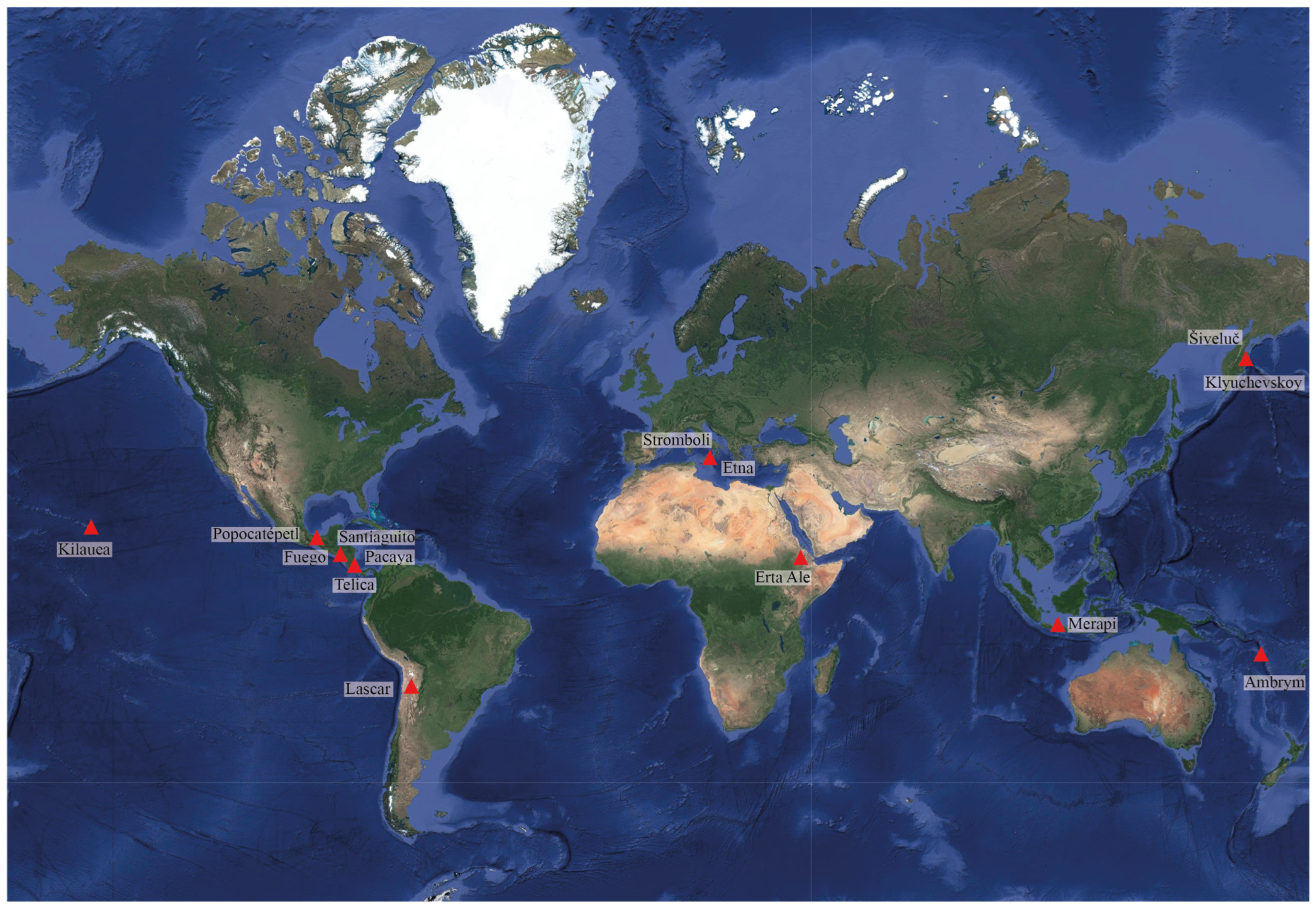
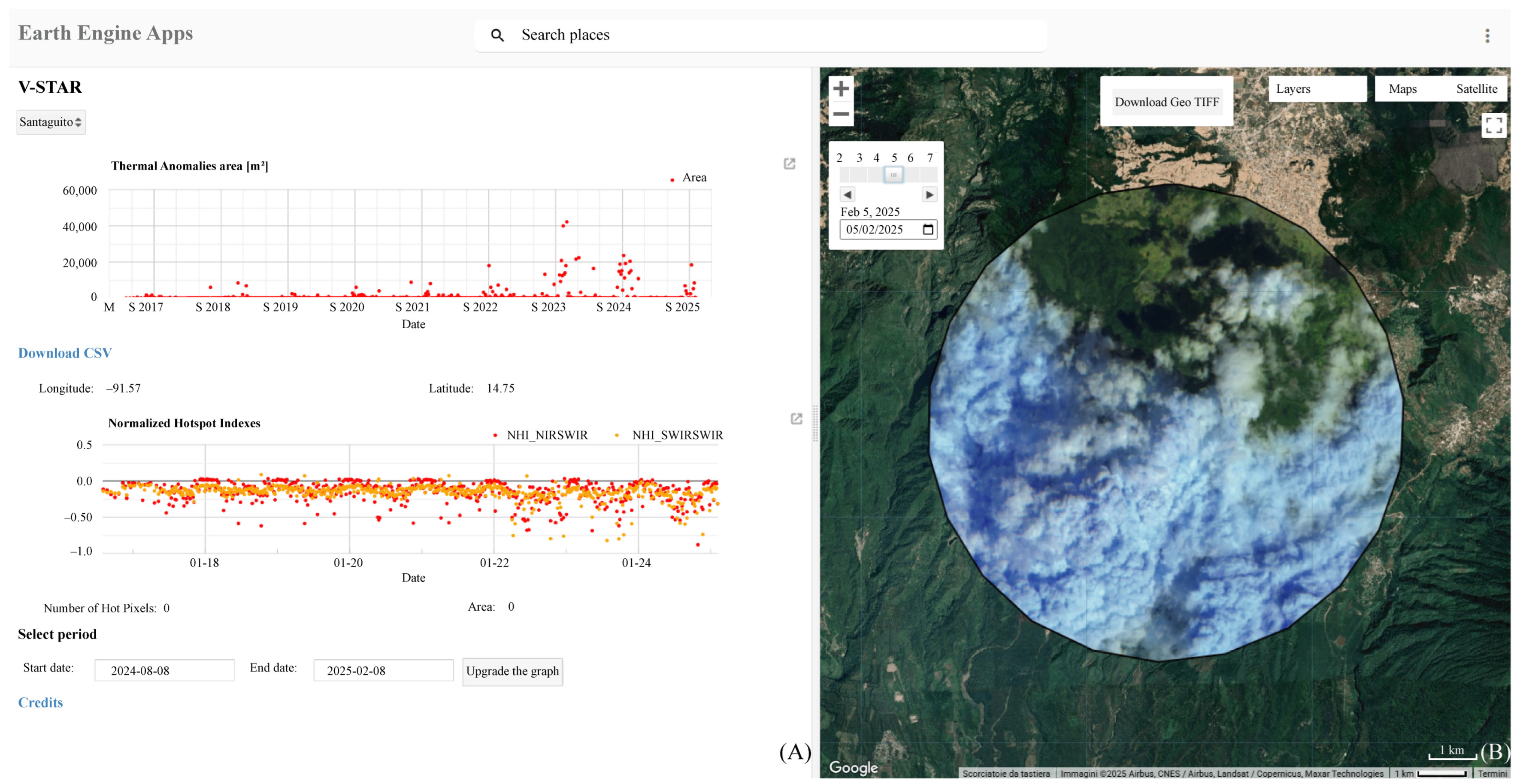
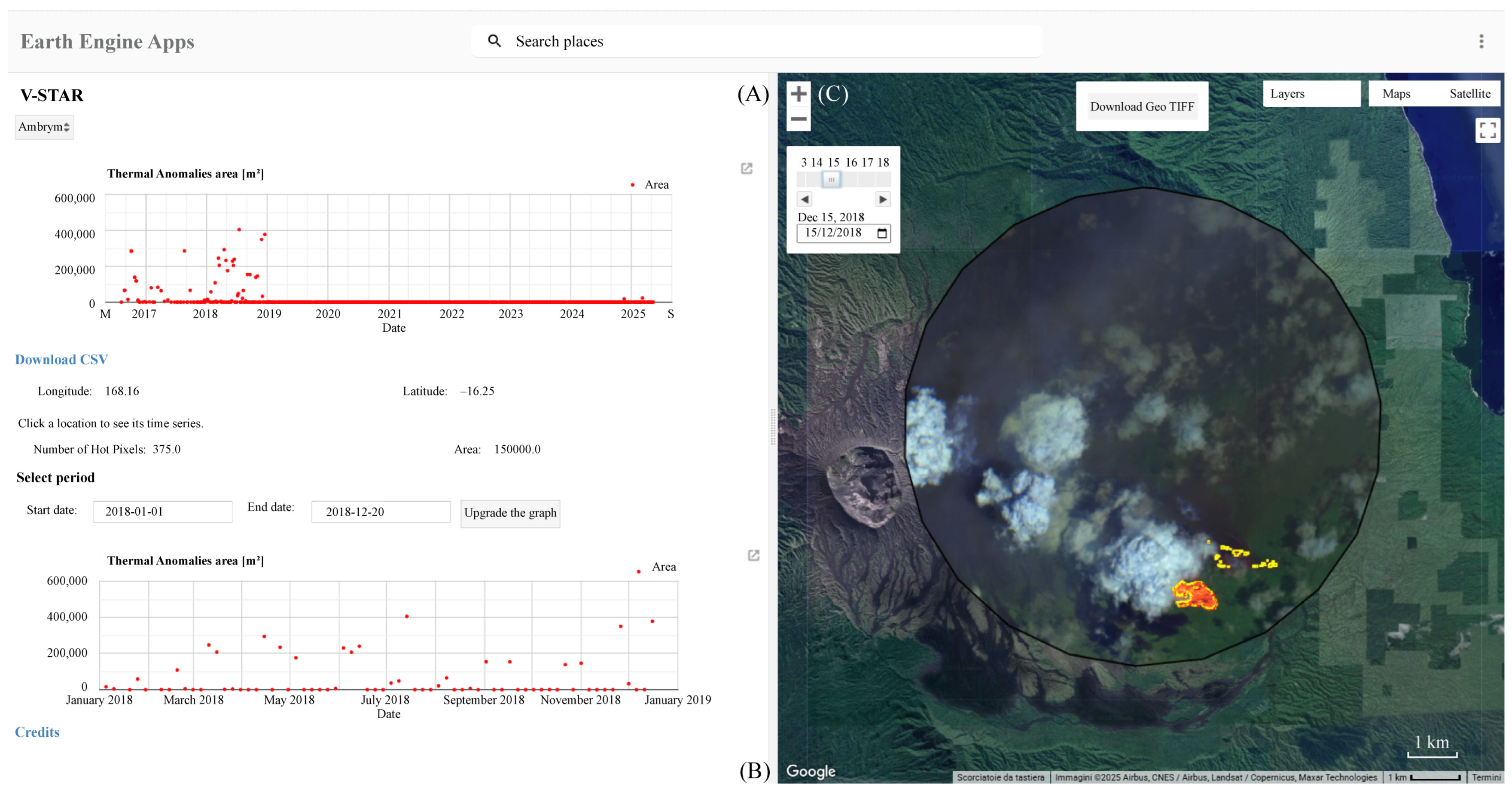
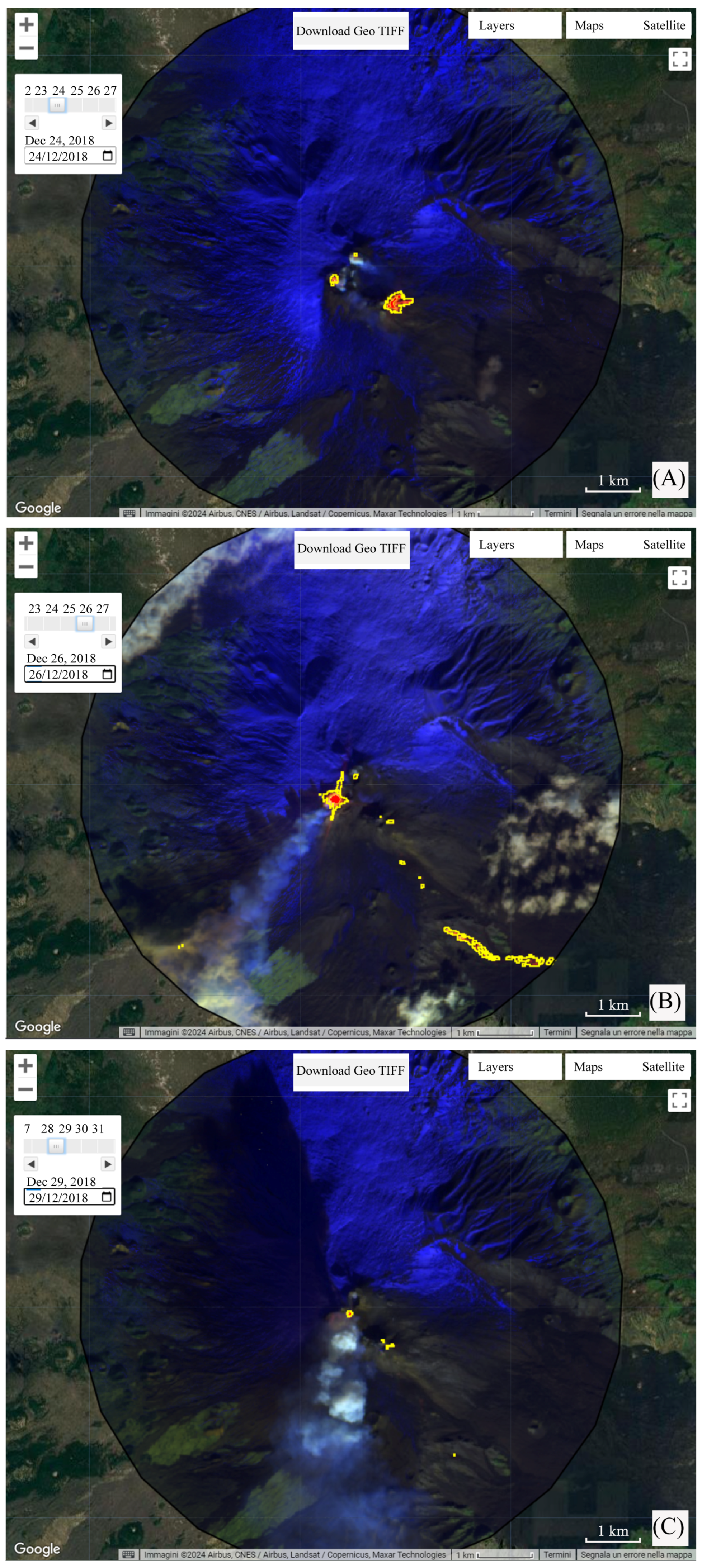
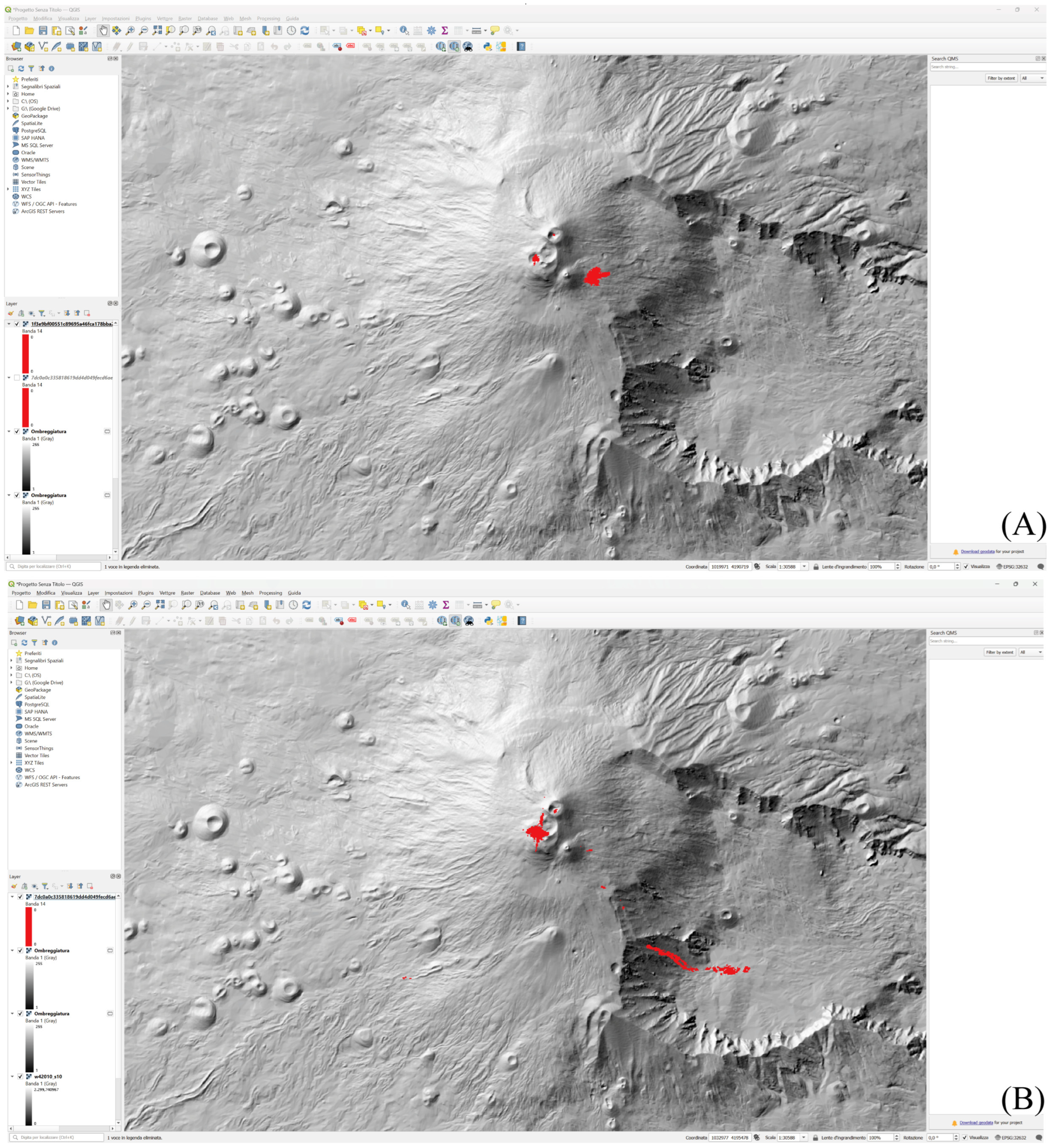
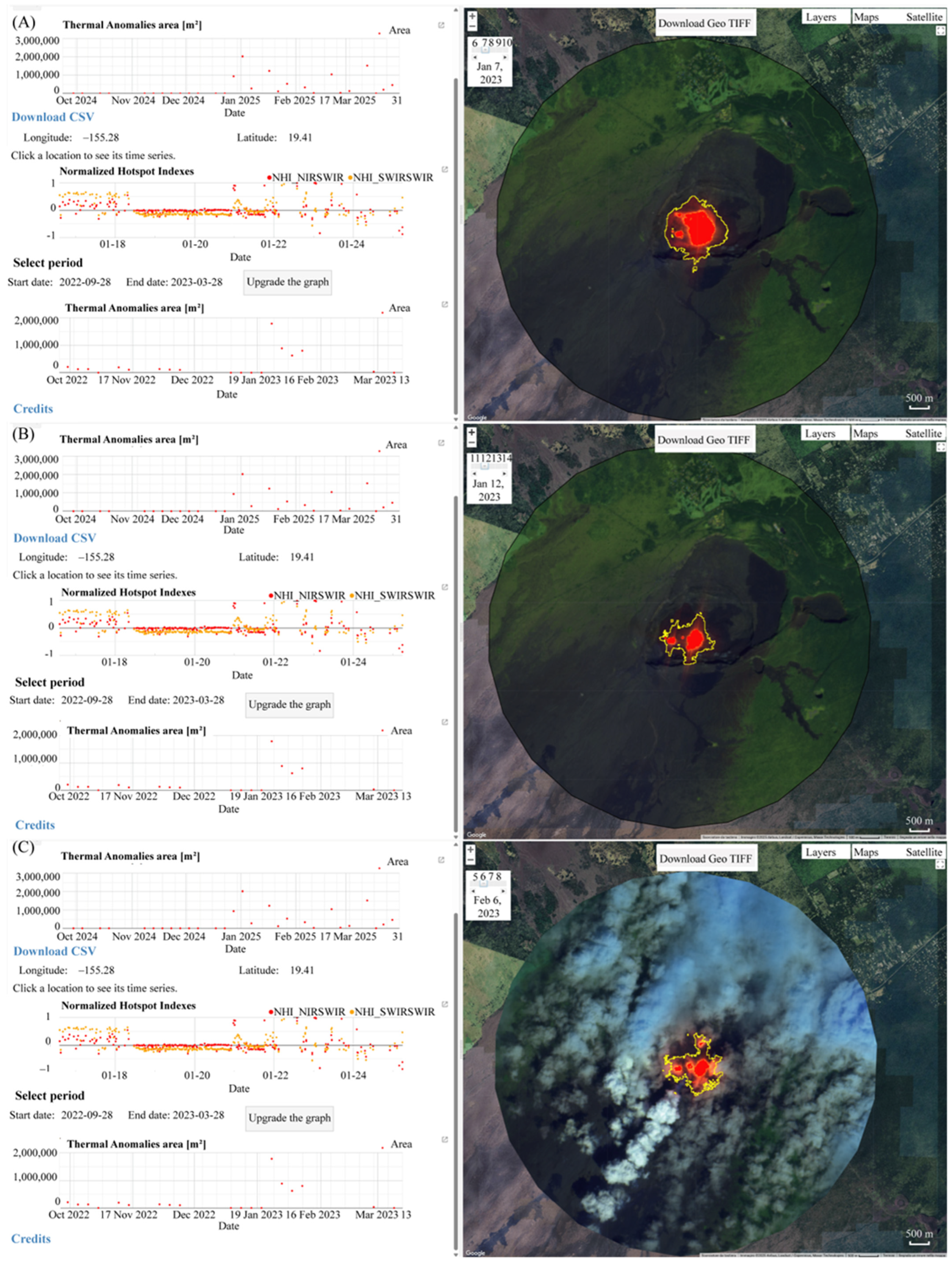
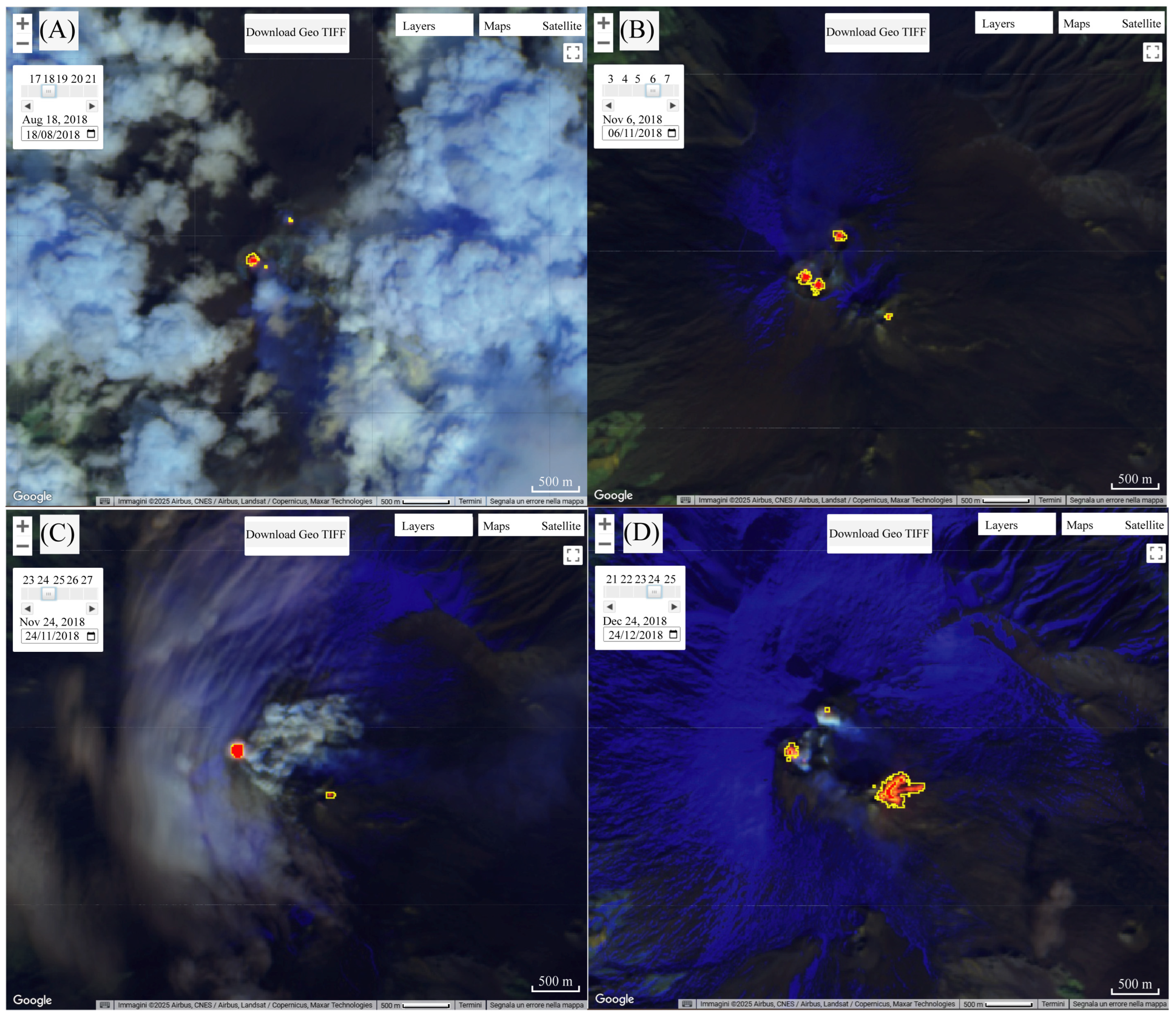
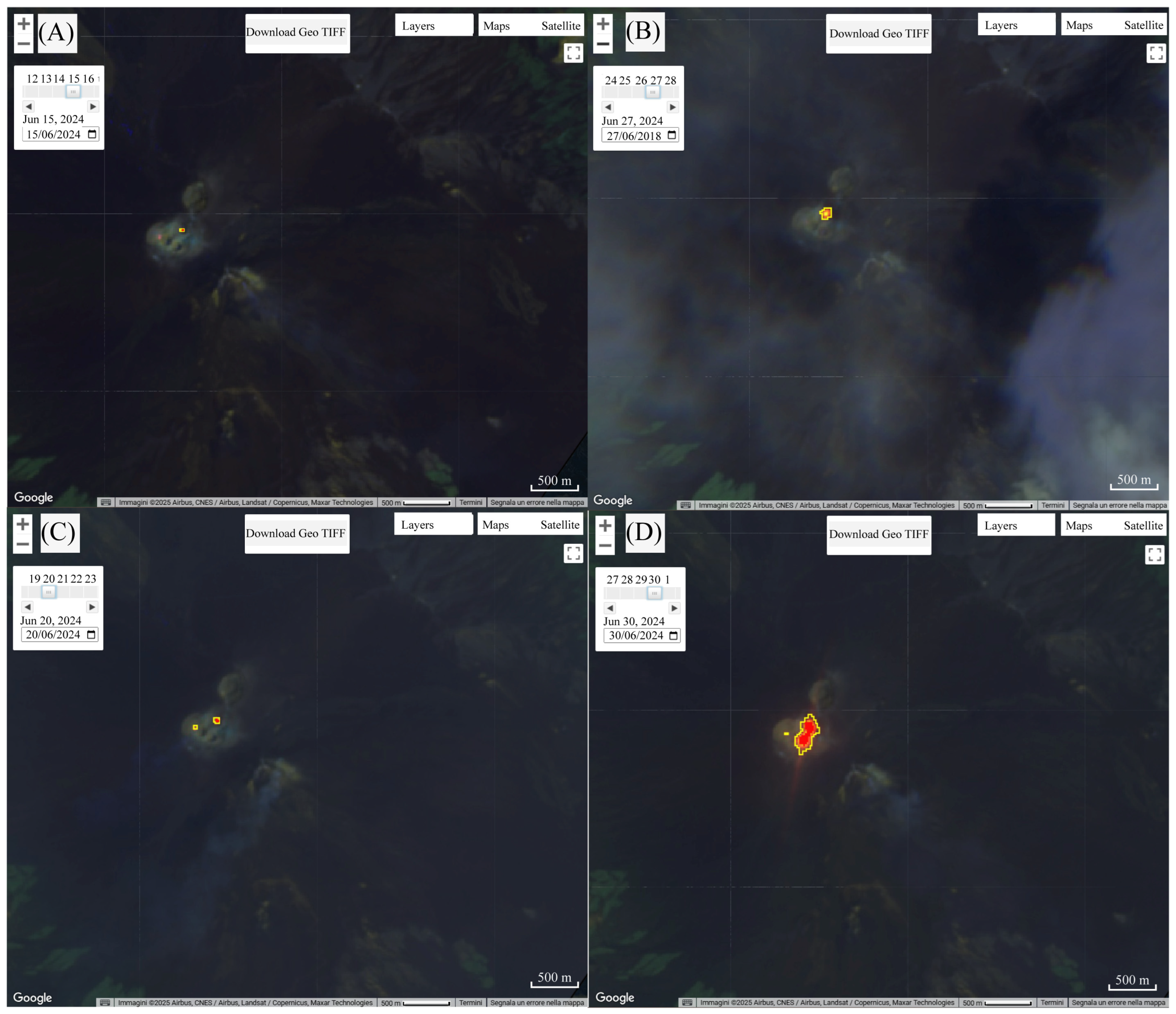
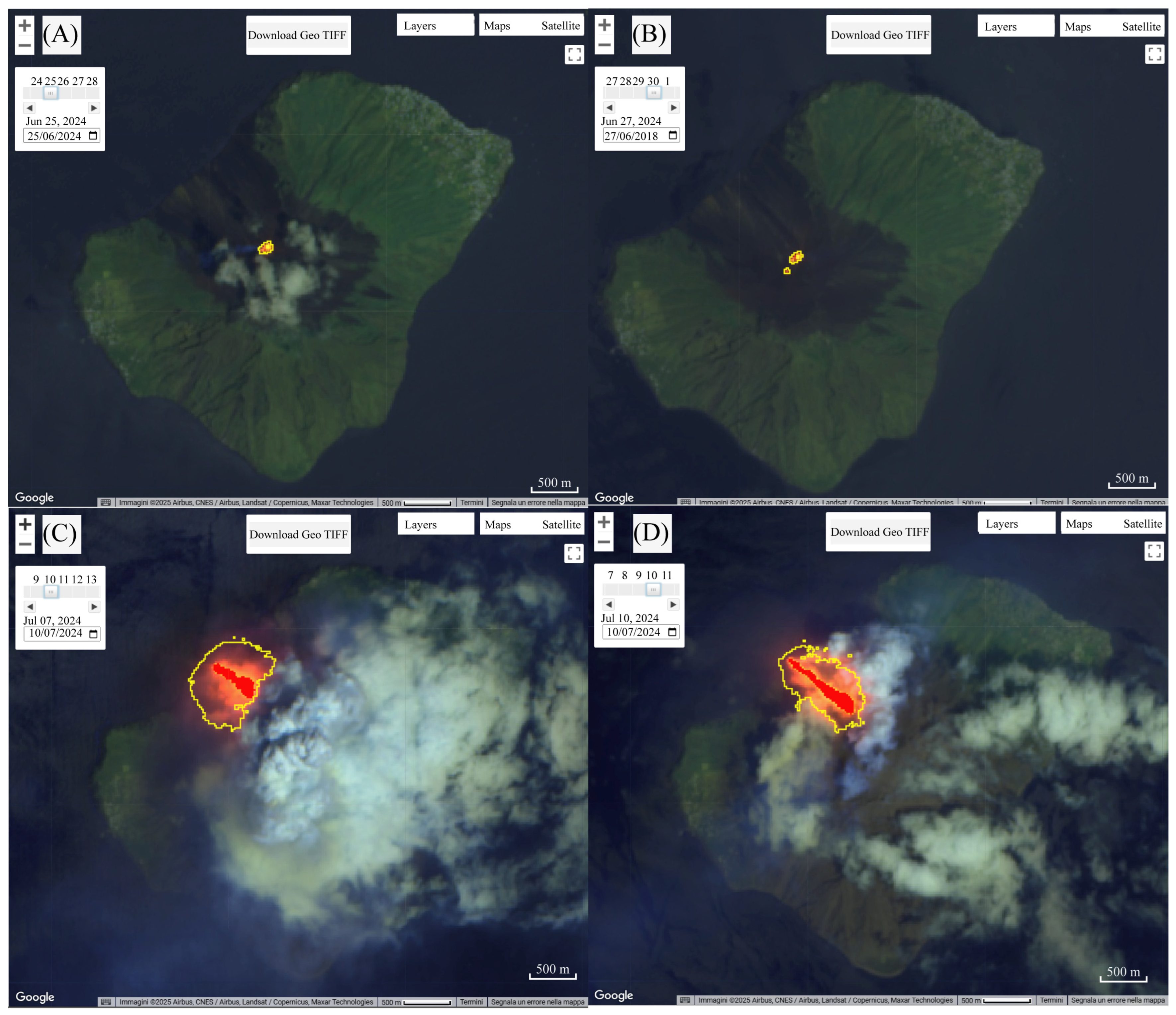
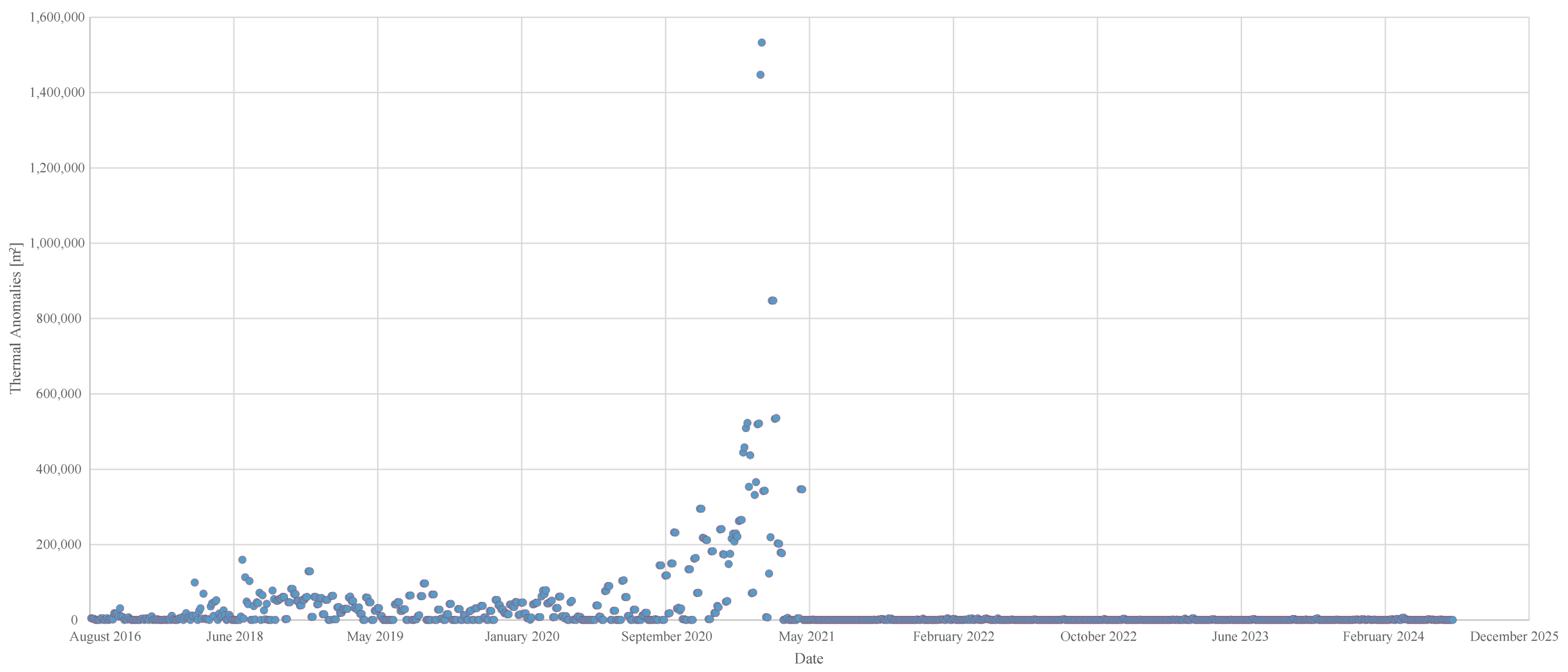

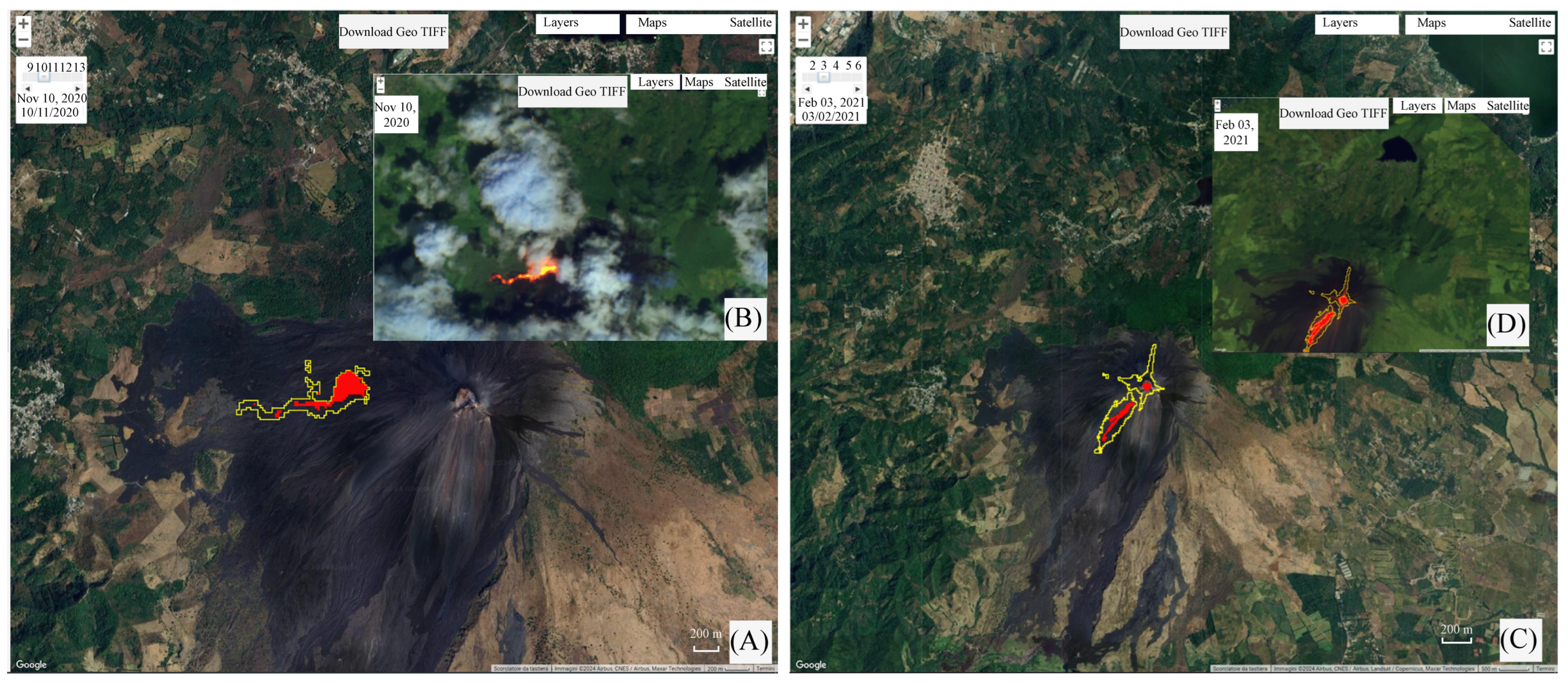
| Band | Description | S2A Wavelength (nm) | S2B Wavelength (nm) | Resolution (m) |
|---|---|---|---|---|
| B2 | Blue | 496.6 | 492.1 | 10 |
| B3 | Green | 560.0 | 559.0 | 10 |
| B4 | Red | 664.5 | 665.0 | 10 |
| B5 | Red-edge 1 | 703.9 | 703.8 | 20 |
| B8A | Near Infrared narrow (NIRn) | 864.8 | 864.0 | 20 |
| B11 | Shortwave Infrared 1 (SWIR1) | 1613.7 | 1610.4 | 20 |
| B12 | Shortwave Infrared 2 (SWIR2) | 2202.4 | 2185.7 | 20 |
| Feat2 |
|---|
| L0.4 |
| L0.5 |
| L0.6 |
| L0.8 |
| L1.6 |
| L2.2 |
Disclaimer/Publisher’s Note: The statements, opinions and data contained in all publications are solely those of the individual author(s) and contributor(s) and not of MDPI and/or the editor(s). MDPI and/or the editor(s) disclaim responsibility for any injury to people or property resulting from any ideas, methods, instructions or products referred to in the content. |
© 2025 by the authors. Licensee MDPI, Basel, Switzerland. This article is an open access article distributed under the terms and conditions of the Creative Commons Attribution (CC BY) license (https://creativecommons.org/licenses/by/4.0/).
Share and Cite
Cariello, S.; Malaguti, A.B.; Corradino, C.; Del Negro, C. V-STAR: A Cloud-Based Tool for Satellite Detection and Mapping of Volcanic Thermal Anomalies. GeoHazards 2025, 6, 24. https://doi.org/10.3390/geohazards6020024
Cariello S, Malaguti AB, Corradino C, Del Negro C. V-STAR: A Cloud-Based Tool for Satellite Detection and Mapping of Volcanic Thermal Anomalies. GeoHazards. 2025; 6(2):24. https://doi.org/10.3390/geohazards6020024
Chicago/Turabian StyleCariello, Simona, Arianna Beatrice Malaguti, Claudia Corradino, and Ciro Del Negro. 2025. "V-STAR: A Cloud-Based Tool for Satellite Detection and Mapping of Volcanic Thermal Anomalies" GeoHazards 6, no. 2: 24. https://doi.org/10.3390/geohazards6020024
APA StyleCariello, S., Malaguti, A. B., Corradino, C., & Del Negro, C. (2025). V-STAR: A Cloud-Based Tool for Satellite Detection and Mapping of Volcanic Thermal Anomalies. GeoHazards, 6(2), 24. https://doi.org/10.3390/geohazards6020024








